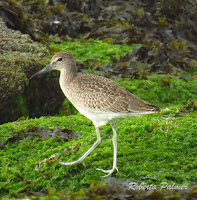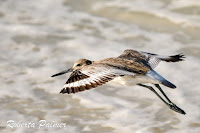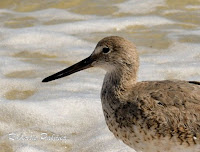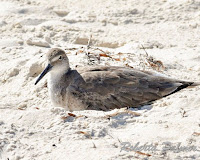WILLET
WILLET – (Tringa semipalmata) – (See images below)
DESCRIPTION: The Willet is a shorebird. In breeding plumage it is mottled brown almost all over. The legs are dark grey. The bill is also dark and straight, and slightly longer than the head. In the winter the plumage is grey. When flying, their wings display large white and black bands. It is fairly large at about 40 cm (15 inches) long.
VOICE: https://www.xeno-canto.org/species/Tringa-semipalmata – When alarmed willets emit a piercing call.
NAME: The English name ‘Willet’ would be an onomatopoeia for the bird’s call. The Latin genus name ‘Tringa’ means ‘sandpiper’, and the Latin species name ‘semipalmata’ means just that, semipalmated.
HABITAT: Coastal salt marshes and prairie freshwater marshes.
DIET: Willets hunt for small invertebrates in the mud or sand.
NESTING: They breed on the ground in a well hidden depression among wetland grasses. Around four greenish eggs are laid, which are incubated by both parents. The male cares for the chicks. If a predator – including a human – gets too close to the nest, this bird will do the ‘broken wing trick’ (limping with an extended wing dragging on the ground) to lure the potential predator away from the nest.
DISTRIBUTION: This species inhabits salt marshes on the Atlantic coast, and winters further down that coast in South America. Another group breeds on the prairie freshwater marshes in the west part of North America. Some individuals have been able to reach Hawaii (see note below on bird vagrancy).
Distribution map: https://en.wikipedia.org/wiki/Willet#/media/File:Tringa_semipalmata_map.svg
ON PEI: The willet breeds on Prince Edward Island, and is considered as ‘common’ to ‘fairly common’ except in the winter
CONSERVATION: Willet populations have been impacted by hunting for food in the past century, and more recently by habitat loss, as for most other shorebird species.
NOTES: The Willet is part of the sandpiper family, shorebirds with many similarities.
Vagrancy: In biology this means an animal going way outside its normal range. For birds, this can happen when there are storms and they get blown off course. On other times, the bird simply wanders in a different direction than usual. Here’s an article about vagrancy in birds.
SIMILAR SPECIES: Greater Yellowlegs, Lesser Yellowlegs
REFERENCES: https://www.borealbirds.org/bird/willet
https://www.mba-aom.ca/jsp/toc.jsp (Maritimes Breeding Bird Atlas)
http://identify.whatbird.com/obj/217/_/Willet.aspx
https://www.audubon.org/field-guide/bird/willet
https://www.allaboutbirds.org/guide/Willet/id
http://www.nhptv.org/natureworks/willet.htm (New Hampshire PBS)
https://en.wikipedia.org/wiki/Willet
DESCRIPTION: The Willet is a shorebird. In breeding plumage it is mottled brown almost all over. The legs are dark grey. The bill is also dark and straight, and slightly longer than the head. In the winter the plumage is grey. When flying, their wings display large white and black bands. It is fairly large at about 40 cm (15 inches) long.
VOICE: https://www.xeno-canto.org/species/Tringa-semipalmata – When alarmed willets emit a piercing call.
NAME: The English name ‘Willet’ would be an onomatopoeia for the bird’s call. The Latin genus name ‘Tringa’ means ‘sandpiper’, and the Latin species name ‘semipalmata’ means just that, semipalmated.
HABITAT: Coastal salt marshes and prairie freshwater marshes.
DIET: Willets hunt for small invertebrates in the mud or sand.
NESTING: They breed on the ground in a well hidden depression among wetland grasses. Around four greenish eggs are laid, which are incubated by both parents. The male cares for the chicks. If a predator – including a human – gets too close to the nest, this bird will do the ‘broken wing trick’ (limping with an extended wing dragging on the ground) to lure the potential predator away from the nest.
DISTRIBUTION: This species inhabits salt marshes on the Atlantic coast, and winters further down that coast in South America. Another group breeds on the prairie freshwater marshes in the west part of North America. Some individuals have been able to reach Hawaii (see note below on bird vagrancy).
Distribution map: https://en.wikipedia.org/wiki/Willet#/media/File:Tringa_semipalmata_map.svg
ON PEI: The willet breeds on Prince Edward Island, and is considered as ‘common’ to ‘fairly common’ except in the winter
CONSERVATION: Willet populations have been impacted by hunting for food in the past century, and more recently by habitat loss, as for most other shorebird species.
NOTES: The Willet is part of the sandpiper family, shorebirds with many similarities.
Vagrancy: In biology this means an animal going way outside its normal range. For birds, this can happen when there are storms and they get blown off course. On other times, the bird simply wanders in a different direction than usual. Here’s an article about vagrancy in birds.
SIMILAR SPECIES: Greater Yellowlegs, Lesser Yellowlegs
REFERENCES: https://www.borealbirds.org/bird/willet
https://www.mba-aom.ca/jsp/toc.jsp (Maritimes Breeding Bird Atlas)
http://identify.whatbird.com/obj/217/_/Willet.aspx
https://www.audubon.org/field-guide/bird/willet
https://www.allaboutbirds.org/guide/Willet/id
http://www.nhptv.org/natureworks/willet.htm (New Hampshire PBS)
https://en.wikipedia.org/wiki/Willet
 |
| Willet, PEI, Canada, by Roberta Palmer |
 |
| Willet in flight, FL, by Roberta Palmer |
 |
| Willet close up, FL, by Roberta Palmer |
 |
| Willet, nonbreeding plumage FL, by Roberta Palmer |